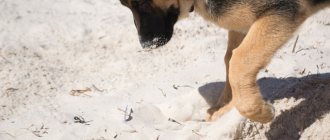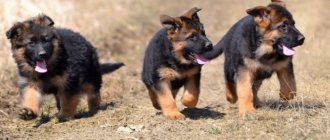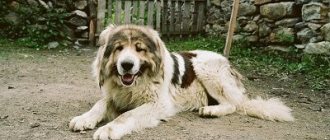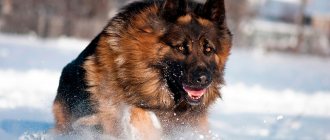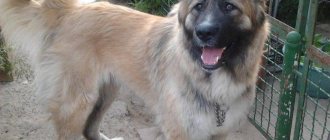Puppy adaptation
Having brought the future defender into the apartment, you need to choose a place that is not in a draft, near a door or radiator. The puppy is given a mattress or rug, preferably with a pillowcase. There should be several of them in order to change and wash them as they get dirty.
How to care for a German Shepherd puppy? At first, the baby will go to the toilet in the apartment. He is gradually taught to relieve himself outside, after feeding or sleeping. You should reward your pet with something tasty. During the first days, a German Shepherd puppy may whine, missing its mother or kennel. You need to calm him down with gentle words, offer him a toy, and not tie him up or lock him in a dark place. But for the benefit of further proper upbringing, you should not constantly pet and squeeze the dog.
We recommend this article:
How to choose the right healthy German Shepherd puppy
Keeping a German Shepherd puppy
German Shepherd puppies can be raised both in a city apartment and on the street in a spacious enclosure or the yard of a private house. However, breeders give the following recommendation: up to 3-4 months, the pet must communicate closely and daily with the owners so that good contact is established between the dog and the owner.
The rules for keeping a German puppy are as follows:
- The pet should be given a place to rest. Inside a house or apartment, a mattress or soft bed is used for this, which is placed far from the front door.
- If the puppy lives on the street, he is provided with a warm and moderately spacious booth (approximate dimensions 100*80*80 cm (l*w*h)). You cannot raise a baby in an enclosure if it is very cold outside. Straw, hay, and dry coarse shavings can be used as bedding.
- You need to walk the puppy daily for at least 2-4 hours a day, but only after the vaccination quarantine has been observed. In this case, the baby must walk on dirt roads and small embankments. It is useful to let your German swim; such physical activity contributes to the proper formation of the skeleton and muscle mass.
- If the floor in the house where the puppy lives is very slippery, it must be covered with carpet. This must be done so that the baby does not damage his paws, and his joints form correctly.
- Once every 3-4 months, a puppy, and then an adult dog, must be treated for internal and external parasites, including ixodid ticks.
It is strictly not recommended to keep a German Shepherd on a chain or other tether. These animals need constant contact with their owner, so it is better if such a dog lives next to a person (inside the house or in the yard without restrictions on movement).
Features of feeding
The owner must properly organize the diet of his German. The following feeding methods are practiced: dry food, natural products and a combined method. There are features of feeding a puppy and an adult dog at home.
Puppy
Proper care of a German Shepherd dog means feeding it healthy food. For the first 2 weeks in a new place, the baby should receive the food he is used to. For the puppy, purchase a nickel-plated bowl on a stand, which is adjusted to the level of the chest.
Related article: How to choose the right healthy German Shepherd puppy
As the baby grows, the height of the stand also changes (this way you can avoid problems with the spine). While the puppy is eating, fix its stance by adjusting its paws. The drink in one of the bowls is changed 3 times a day. The food should be crushed, barely warm and smell good. After eating, the baby's face is wiped with a rag.
We recommend this article:
Weight and height of a German Shepherd puppy by month
At 1 month the puppy is fed 6 times, at 2 months - 5-6 times, from 3 to six months - 3-4 times, from 6 months to a year - 2-3 times. The frequency of feeding an adult animal is 2 times a day. For the first time in the house, the puppy is given a small portion - if he eats, licks and moves away from the dishes, then there is enough food. The basis of the baby’s diet is protein foods, that is, raw meat, eggs, dairy products. You should not feed your puppy only cereal. They give not minced meat, but fresh veal, beef and horse meat in the amount of 50 g at the age of up to a month, then 100 g each and gradually increasing the daily norm.
By-products (lungs, heart, kidneys, udder, tripe) are given to a 4-month-old puppy three times a week. Eggs are fed once a week, 2 pieces. They also give about 350 g of cottage cheese, yogurt and kefir, goat and cow milk. Bread and cereals are needed in small quantities. Don't forget about grated vegetables, fruits and berries. A good vitamin supplement with herbs.
Adult dog
The daily diet of an adult animal kept at home includes lean, scalded and lightly cooked meat.
It is better to give rabbit, beef, chicken, turkey, but not pork. They continue to cook porridge from millet, buckwheat, oatmeal and rice. It is allowed to give pumpkin, carrots, zucchini and bell peppers. Seasonal vegetables are useful - for example, apples and pears. Lactic acid products are also necessary, 1 tsp. vegetable oil per day, honey. Unlike a puppy, an adult pet over a year old can be given sea fish - twice a week, boneless and boiled. Do not feed dogs fatty meats, smoked meats, tubular bones, or fried foods. Pasta, seasonings, baked goods, chocolate and other sweets, legumes and carbonated drinks are also prohibited.
Similar article: What vaccinations are required for a German Shepherd dog?
Dry food for German Shepherd puppy
Dry food is a product whose composition is completely balanced.
They are divided into four classes:
- Economy (Chappi, Darling, Trapeza, Pedigree, etc.). Such feeds have the lowest cost (50-80 rubles per 1 kg). They are sold not only in pet stores, but also in regular supermarkets. To prepare economy class food, the cheapest raw materials are used; it also contains a low percentage of animal protein, but there are many plant ingredients, so they should not be used as the main diet for a pet, especially a puppy. Some products contain flavor enhancers and dyes, which is why the dog consumes them with greater appetite.
- Premium (ProBalance, Dow Chow, Happy Dog, Purina One, Proplan, etc.). These feeds have a higher cost: 100-200 rubles. for 1 kg. Such products contain more ingredients of animal origin, but they also contain a high percentage of plant proteins. An advantage of premium diets is the ability to take into account the age characteristics of the pet (the line includes products for puppies, for adult and elderly dogs, etc.).
- Super premium (Arden Grange, 1st Choice, Josera, Belcando, etc.). These feeds have an average cost of 300-600 rubles. for 1 kg. To produce super premium products, high quality raw materials are used. They contain large amounts of animal protein, and plant ingredients include rice and other highly digestible grains. Such diets contain vegetables, berries, fruits, healthy mineral supplements and vitamins. They do not contain flavor enhancers or dyes. Many manufacturers produce products not only for daily consumption, but also special veterinary diets.
- Holistic (Almo Nature, Barking Heads, NOW, GO!, Acana, etc.). These products have the highest cost: 800-1200 rubles. for 1 kg. Their composition is completely balanced. Holistic food contains a large percentage of animal proteins (up to 70-80%), obtained from high quality meat. Many diets are completely grain-free. Sources of carbohydrates are vegetables and fruits (yams, potatoes, apples, etc.). Holistic feeds are rich in vitamins and minerals and contain probiotics, making them easily digestible by animals.
The daily amount of dry food for a German Shepherd puppy depends on the brand and class of the product. High-class diets (super-premium and holistic) have high nutritional value and excellent digestibility, so the consumption of such feed is noticeably less.
For example, a puppy aged 3-4 months will need about 400 grams of high quality food, while the norm for an economy class product will be 450-500 grams.
REFERENCE! Many breeders use Royal Canin food as the main diet for both German Shepherd puppies and adult animals. This product belongs to the super-premium class. The Royal Canin line includes diets for babies from 2-3 weeks, which allows it to be used as a first complementary food.
Walks in the open air
Next, we will talk about the features of keeping and caring for animals of this breed. Full care for a shepherd is impossible without walking. When the puppy has received the necessary vaccinations, he needs to be walked regularly and for a long time. The first walks do not last more than 5 minutes. A two-month-old puppy is accustomed to a leash and walked for up to half an hour.
By 6–10 months, the duration of the walk increases to 2–3 hours. The pet needs communication with other purebred dogs, and it is better to protect it from strays. It is better to take your pet out during the day so that it receives beneficial ultraviolet light.
How to care for a German Shepherd. German Shepherd: care and nutrition.
A German Shepherd is not just a dog, it is not a pet, it is a real friend who will help in trouble, who will always support, with whom you can share secrets. Yes, this particular breed of dog replaces a person with a real friend with whom you can move mountains. This is not just so, the fact is that this type of dog is very loyal, and most importantly, hunting. In this article we will talk about how to raise, feed and care for a German Shepherd.
The German Shepherd is a breed of dog that was used for detection activities as well as herding. That is why this breed of dog is used in the army and police, and is considered the most intelligent of all types of dogs. The German Shepherd, oddly enough, was developed through selection and crossing of several species. Therefore, you can often find not a purebred dog, but a cross with other breeds. But it is the pure breeds that are most valued, which are not so easy to find. The Shepherd is divided into two types: smooth-haired and long-haired. The first type is the most common. As a rule, this breed is still used in protection, and this activity is the main one for it. Initially, the place of birth and appearance of such a species as the German Shepherd is considered to be Germany and Asia Minor. But, oddly enough, the progenitor of this breed is a wolf from the regions of Russia. Let's take a closer look at the features of this breed. The German Shepherd has a balanced type of behavior and is also prone to following commands and reflexive actions. That is why it is considered that she is the most obedient, and can carry out absolutely any command that is instilled in her from a young age. It is successful if it has one owner, but this breed of dog can easily get used to another person; it does not become too attached to the same owner. That is why it is not scary to have one in a family, unlike, say, boxer dogs, which listen to only one owner, while others can be torn to pieces. The German Shepherd will listen to the commands of even a child. She is number three in the ranking of the smartest dogs. But, excessive intelligence can also play a cruel joke. For example, with the command “front”, the dog will think about whether to rush at the person, and only then will it take some action. It “Filters” all the owner’s commands, and if it is inappropriate, then the dog of this breed will not carry out the order. But such cases are extremely rare; often, a German shepherd unquestioningly carries out the orders of its owner. This breed of dog is used not only in search work. It is indispensable for protecting people, and not only people. Such a dog can guard livestock in the pasture, preventing both the animal and strangers from approaching it. She copes well with her duties while hunting, bringing prey to her owner. Well, and, of course, she can be a guide for blind people, as she has excellent intuition and is amenable to training and commands. Caring for a German Shepherd. Despite the fact that it seems to be a simple and undemanding breed, the German Shepherd needs good and high-quality care. We will tell you further how to monitor the animal. You should brush it about twice a week. To do this, use special massage combs so that they do not have sharp teeth. You should brush along the coat, from head to tail. Remember that your dog can shed, so if he lives in your apartment, be prepared for a lot of hair. Attention! Only if the hair becomes too long, in particular on the hind legs, can it be cut off. The animal should be bathed with a special shampoo, but, oddly enough, this should be done twice a year. In the summer, you can practice commands in the water, but remember that there should be no people near the lake or river. Only if the dog is hot can you spray it with a hose or a sprinkler. But hygienic cleaning should not be frequent, otherwise the oils on the wool will be washed off and it will become dull. When bathing, you can use a special brush that will remove dirt from under the fur. Any animal should not sit still. This is what distinguishes it from many people who are motionless. German dogs require special active attention. They belong to the category of sporting breeds, and therefore, they need physical activity almost every day. Teach them from childhood to bring various things, these can be both sticks and toys, in the form of a ball, a rubber bone, and so on. There are also special areas for animals, where barricades and dog trainers are installed. Take the time to take your pet there at least once a week so that he gets the necessary exercise. In addition to physical activity, the German Shepherd needs exercise. Therefore, they should be constantly trained and given commands. In addition, try to confuse them, deceive them, and they will develop even more mentally. You should provide a home for your pet. He must have his own corner, and this will be only his territory. If you live in your own house, make an enclosure and place a booth in it. Only if this is an apartment, then separate with a rug the place where he will sleep. Remember that you should not go in there and touch the dog when he is resting, and do not let him do the same. Place soft toys or rubber toys especially for animals in the German Shepherd's habitat. This is especially important when he is still a puppy. Only if the dog asks to go outside, be sure to get off your butt and go for a walk with him. And if he “gave” you a gift, then do not scold him, since it is your fault. Accustom your puppy to commands and to the collar from childhood. If you don’t put a collar on him in childhood, then later you simply won’t be able to control him. The same goes for teams. As soon as he is one month old, start training the puppy. If you want him to professionally carry out all commands, take the German Shepherd to a special institution where they are trained. But, you can do everything yourself. To do this, you will need the Internet, which describes how to teach a dog to follow commands, and time for training. Call the dog only by its name, no offensive words. Do not hit or scold him under any circumstances, and if the animal has committed an offense, then explain that this is not possible, you can punish him, for example, not give him a treat, or not give him a toy. He will understand everything. Be sure to undergo a medical examination and all necessary vaccinations. If you use these tips, you will be able to raise a good friend. German Shepherd nutrition. The diet for this dog is not complicated. He does not need special feed, and is ready to eat field cuisine. This is its versatility, which is why the German breed is used in the army and police. But, like humans, a dog needs a large amount of protein to thrive. He needs to be fed meat, fish, and yolks. All this can be mixed with products of plant origin, such as porridge. Give your German Shepherd some sheep or cow bones. He will be happy, and among other things, his grip and bone power will develop. You should please your animal with dairy products to strengthen its bones and teeth. This breed should be fed either often or a lot. It is better to distribute the diet so that the dog knows at what time it will be fed food. Remember that after feeding, he may want to go outside, and you will need to take the time. But, you can predict it by teaching yourself to eat at the same time. Food should not be given hot, but not cold either. The volumes will be quite large when the German Shepherd grows up. You should not skimp on feeding such a dog. He can easily eat a bucket of porridge at one time, and for him this will be the norm. But, add meat, bones, or butter to the porridge. You can also make it with milk so that the animal’s body is filled with the required amount of proteins. You can accustom your dog to special food, but you should remember that weaning it will not be easy. Only if you taught your puppy to eat food as a child, and now you want to switch it to regular food, then you can do this in two ways. The first is long, slow, but tactful. Gradually mix regular food into the food, then food into the regular food, and this way you can wean her off the food completely. The second method is done quickly, but is painful for your nerves. Just replace the food and that's it. The dog will refuse to eat, but a day or two will pass, and it will begin to pinch both cheeks. The choice is yours. You should feed your German Shepherd vegetables and fruits periodically if he accepts these foods. Then the animal’s body will be enriched with useful minerals, and it will feel comfortable and will serve you for many years. In general, caring for a German Shepherd is very similar to caring for a small child, so if you have a child, then you will not have any problems, and if you are just planning to have a baby, then a German Shepherd will be an excellent preparatory training. Remember the main thing, you are not raising a toy, but an intelligent and well-mannered animal that will be your friend, help you out in trouble, and will bring you joy.
Bathing and grooming
When talking about the care and maintenance of a domestic German Shepherd, it is worth mentioning hygiene. Frequent bathing disrupts the natural protective layer of the skin and harms the health of the coat. It is recommended to completely wash the puppy with a special shampoo from 3 months and no more than 3 times a year. After the procedure, the dog is wiped and dried. You can remove dust or dirt after a walk by rinsing the animal with warm water. Coat cleaning is carried out daily, standing to the left of the pet. How to care for a German Shepherd so that tangles do not appear on the fur? You need to comb your pet as often as possible.
What a German Shepherd should be able to do by month
With normal care and proper upbringing, the puppy usually already learns:
2-3 months
Approaching the owner, sitting in front of him, the basics of fetching and playing catch, walking on a leash (we get used to not pulling on the leash and not dangling on it), the command: “Place!” and the basics of searching for an object.
3.5-4 months
Approach on command, correct landing at the left leg, walking around the owner from behind after the command: “Come to me!”, correct movement on a leash (does not pull or lag behind) with turns (the length of the “track” is no more than 50 m), searching for and fetching a hidden person object (no more than 3 meters), the basics of working on a scent trail.
Please note that games of tugging with a stick or rag stop before the complete change of teeth appears. Handling or chewing objects is not prohibited.
Video on how to teach a shepherd the command “Sit!”, “Lie down!”, “Stand!”
5-6 months
The puppy correctly executes the usual commands, gives the fetch object on command, and executes the command: “Near!” and the unconditional command: “Ugh!” or “You can’t!”, when the movement stops, it automatically sits down, showing no interest in strangers and animals, and remains for a few seconds in a lying position on command.
Video on how to teach a shepherd the command “Fetch!”
6.5-7 months
The starting position at the left leg is taken up automatically, the retrieving object is given into the hands of the owner after taking the starting position, the dog walks side by side without coercion with a sagging leash (the beginning of learning to walk side by side without a leash), a good grip is practiced.
Tip: Your German Shepherd puppy will love to play tug because he has enjoyed it since he was a baby. But his teeth are still weak, sharp jerks can cause pain or damage the tooth. Therefore, you will not pull the fabric with jerks towards you. And, immediately after 2-3 tugs by your dog, release the fabric and let the young warrior enjoy the victory, strengthening his confidence in his own abilities.
Confidence for a puppy BUT is a future calm reaction to external stimuli without panic or aggression.
Video on how to teach a shepherd the commands “Come to me!”, “Nearby”, “Place”
7-8 months
Developing self-control and accustoming to gesture commands at a distance, consolidating acquired knowledge through constant repetition during games and walks, reinforcing the command: “Lie down!” and the first attempts to crawl on command, we learn to take barriers (no higher than 50 cm) and walk on a boom on command.
8-10 months
We consolidate our knowledge and learn to climb and descend open stairs.
After 10 months
You can contact a professional trainer (if you have not visited the breeding area) for advice on refining the techniques and the degree of readiness of your young German Shepherd for the mandatory general training course - OKD.
A list of skills by month is not an accurate guide! It describes the ideal dog. Usually it coincides with reality by 50-70%. Some kids master one exercise early, but never get the chance to do another. For some it's the other way around.
There is no need to demand that all points be performed flawlessly; it is enough if the puppy is familiar with the techniques and tries to perform them with your support.
If desired, and in consultation with a specialist trainer, you can expand the range of required skills for a puppy, BUT, however, it is better to begin with a little, but firmly, than a lot and anyhow.
Cleaning ears and teeth
Keeping a German Shepherd also means caring for your pet’s ears and teeth. Teeth cleaning is carried out once every 3 months with powder or toothpaste for dogs. Artificial bones containing fluoride help clean fangs and develop jaws. When studying the question of how to properly care for a German Shepherd, remember that the ears are cleaned with a cotton swab or a special preparation. Regular examination of the ears for inflammation or redness is required.
We recommend this article:
When do the ears of a German Shepherd stand up and the reasons for improper landing?
Features of caring for an adult dog
How to care for a shepherd? What should you pay attention to? To keep your dog healthy and well-groomed, you need to first look after its coat, eyes, ears and teeth.
Grooming
A shiny coat is an indicator of the overall health of a German Shepherd. Grooming consists of brushing the dog with a special brush with metal teeth. This helps clean the fur from dirt and dead hairs during seasonal or age-related shedding. It is recommended to brush your German Shepherd 2-3 times a week.
Grooming
Eye care
Eye care should be daily. You need to make sure that no debris or dirt accumulates in the corners of your pet, and remove hair around the eyes. This is done using a cotton swab moistened with a special lotion.
Note! Morning suppuration and watery eyes of a shepherd dog are a signal that you need to contact a veterinarian.
How to trim claws correctly
In summer, this procedure is required extremely rarely, since the claws wear down while walking on the asphalt, but in winter they need to be given special attention. You need to trim the claws with a special nail clipper. Before you begin, determine the boundary between the keratinized part and the “living” part. If this is difficult to do, then you need to trim it gradually, paying attention to the dog’s reaction. After cutting, you need to remove burrs and irregularities that may cause inconvenience.
How to clean your ears
Ears should be examined regularly and cleaned at least once every two days. For cleaning you will need cotton pads and a liquid cleanser or special wet wipes that are used to wipe your ears. If there are crusts, lotion is dripped onto them, pressed with a disk or napkin for a few seconds and removed with massaging movements.
Care of teeth and jaws
Brushing a dog's teeth is just as important as brushing a person's. Special bones and snacks are not enough. You need to brush your teeth with special toothpastes for dogs at least 3 times a week. After cleaning with the paste, it is recommended to use chamomile infusion for rinsing. It can be injected using a syringe.
Every dog needs walks outside.
Walks in the open air
Outdoor walks are recommended for both puppies and adult dogs. During them, the German Shepherd learns about the world around it, gets used to its owner and discipline. A puppy up to 6 months old should walk in the fresh air 4-6 times a day for 15 to 20 minutes. An adult German Shepherd can get by with 2 walks a day, but they should last at least 40 minutes.
Education and training
Knowing how to care for a shepherd, you can move on to education and training. Education begins from the first days the baby appears in the house - he is not allowed to jump on the furniture, they show him who is the boss here. When training, a mechanical, imitative method or reward with food is used. Remember the rules of training: commands are pronounced without insistence or threats, choosing the right intonation. Don't be nervous or make sudden movements. The pet is periodically allowed to rest. If possible, change the place of classes and the sequence of exercises. It is better to carry out training in the morning or evening, and this should be done by the person until the results appear.
We recommend this article:
How long do German Shepherds live at home?


